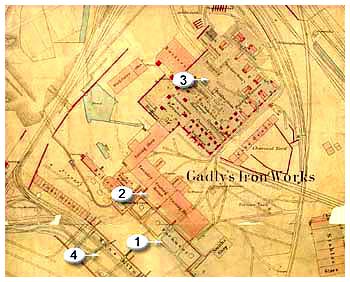| The Gadlys Ironworks |
|
|
The Gadlys Ironworks were opened in 1827 by a partnership of George Rowland Morgan, Edward Morgan Williams and Matthew Wayne. Matthew Wayne had been furnace manager at Cyfartha Ironworks, and with the help of his son Thomas Wayne, was instrumental in developing the sale coal market in the Cynon Valley. When it opened the Gadlys ironworks had only one furnace and this was first put into blast in 1828. When the works were put up for sale in 1835 it included 350 acres of mineral rights and an iron mine employing 150 men, the single blast furnace was capable of producing 1,700 - 2,000 tons of iron per annum. In the proceeding years the works expanded as by 1850 there were three blast furnaces at the site and a fourth was added by 1854. |
| After a period of expansion in the 1860's the Ironworks were at the peak of their development when the First Edition of the Ordnance Survey map was surveyed in 1868. Identifiable on the map are the four Blast Furnaces (1); the Casting House (2); the Puddling Furnaces and Rolling Mills (3) and the Coke Ovens and Mine Kilns(4). |
For much of its life the Gadlys Ironworks produced iron for tinplate bars, but from 1861 production began wrought iron rails. In 1872 fifteen puddling furnaces and two rolling mills were in operation at the works, and the works were capable of producing 500 to 600 tons of rails per week. However, in common with the Aberdare and Abernant Ironworks, the works at Gadlys did not weather the downturn in trade of the early 1870's and production ceased in 1876. |
| The remains of the Gadlys Ironworks are the best preserved of the Cynon Valley Ironworks. The engine house, which housed the engine that supplied the blast, has been restored and the casting sheds are now the sites of the Cynon Valley Museum. The remains of the blast furnaces are also still in a relatively good condition, and can be seen behind the Museum building. |
| |
|
| |

